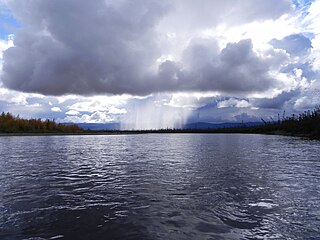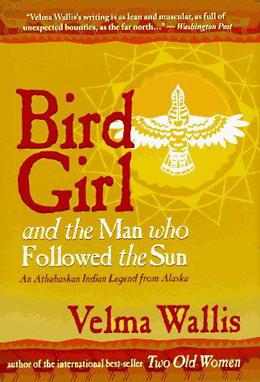Related Research Articles

Fort Yukon is a city in the Yukon-Koyukuk Census Area in the U.S. state of Alaska, straddling the Arctic Circle. The population, predominantly Gwich'in Alaska Natives, was 583 at the 2010 census, down from 595 in 2000.

Athabaskan is a large family of indigenous languages of North America, located in western North America in three areal language groups: Northern, Pacific Coast and Southern. Kari and Potter (2010:10) place the total territory of the 53 Athabaskan languages at 4,022,000 square kilometres (1,553,000 sq mi).

The Gwichʼin language belongs to the Athabaskan language family and is spoken by the Gwich'in First Nation (Canada) / Alaska Native People. It is also known in older or dialect-specific publications as Kutchin, Takudh, Tukudh, or Loucheux. Gwich'in is spoken primarily in the towns of Inuvik, Aklavik, Fort McPherson, and Tsiigehtchic, all in the Northwest Territories and Old Crow in Yukon of Canada. In Alaska of the United States, Gwichʼin is spoken in Beaver, Circle, Fort Yukon, Chalkyitsik, Birch Creek, Arctic Village, Eagle, and Venetie.

The Gwichʼin are an Athabaskan-speaking First Nations people of Canada and an Alaska Native people. They live in the northwestern part of North America, mostly north of the Arctic Circle.

The Yukon Quest, formally the Yukon Quest 1,000-mile International Sled Dog Race is a sled dog race scheduled every February since 1984 between Fairbanks, Alaska, and Whitehorse, Yukon, switching directions each year. Because of the harsh winter conditions, difficult trail, and the limited support that competitors are allowed, it is considered the "most difficult sled dog race in the world", or even the "toughest race in the world"—"even tougher, more selective and less attention-seeking than the Iditarod Trail Sled Dog Race." The originator envisioned it as "a race so rugged that only purists would participate."

Birch Creek is a 150-mile (240 km) tributary of the Yukon River in the U.S. state of Alaska. Beginning at the confluence of Ptarmigan and Eagle creeks near Porcupine Dome, it flows southwest, then south under the Steese Highway and into the Steese National Conservation Area. It then turns east, then north, again passing under the Steese Highway and entering the Yukon Flats National Wildlife Refuge. Turning northwest, it ends where it splits into two distributaries, Lower Mouth Birch Creek and Upper Mouth Birch Creek, near Birch Creek, Alaska. The distributaries flow into the Yukon River at separate locations downstream of Fort Yukon.

The Porcupine River is a 916 km (569 mi) tributary of the Yukon River in Canada and the United States. It rises in the Ogilvie Mountains north of Dawson City, Yukon, Canada. From there it flows north through the community of Old Crow, veers southwest into the U.S. state of Alaska, and enters the larger river at Fort Yukon, Alaska. It derives its name from the Gwich'in word for the river, Ch'oonjik, or "Porcupine Quill River".

The Sheenjek River is a 200-mile (320 km) tributary of the Porcupine River in the U.S. state of Alaska. It begins in the eastern part of the Brooks Range and flows southward to meet the larger river northeast of Fort Yukon.
Claire Specht Fejes was an American artist.

The Hän, Han or Hwëch'in / Han Hwech’in are a First Nations people of Canada and an Alaska Native Athabaskan people of the United States; they are part of the Athabaskan-speaking ethnolinguistic group. Their traditional lands centered on a heavily forested area around the Upper Yukon River, Klondike River (Tr'on'Dëk), Bonanza Creek and Sixtymile River and straddling what is now the Alaska-Yukon Territory border. In later times, the Han population became centered in Dawson City, Yukon and Eagle, Alaska.
John Fredson, was a tribal leader born near Table Mountain in the Sheenjek River watershed of the state of Alaska, United States. He is most noted for gaining federal recognition for the Venetie Indian Reserve in 1941, then the largest reservation in Alaska, and containing approximately 1.4 million acres (5,700 km2). This was before Alaska was admitted as a state.

Chief David Salmon was an indigenous Alaskan that served as Chief of Chalkyitsik and later First Traditional Chief for the Gwich'in people. He was known for his commitment to improving his community and working for the people. Salmon would use his position and influence as chief to begin many public works and create programs dedicated to helping the Gwich'in people. As an advocate for education, Salmon would spread his knowledge by creating traditional Athabascan items for display or teaching his community to keep Athabascan traditions alive. At the same time, Chief Salmon would be trained and become the first Episcopal priest for Interior Alaska and spend a lot of his life spreading his faith.

Two Old Women: An Alaskan Legend Of Betrayal, Courage And Survival is a 1993 novel by Velma Wallis, set in northeastern Alaska.

Bird Girl and the Man Who Followed the Sun is a 1996 novel by Velma Wallis. It describes the lives of two Gwich'in Athabaskans, Daagoo and Bird Girl, who each defy the rules of their culture and strike out on their own.
Woodie West Salmon is a Gwich'in Indian who was a member of the Alaska House of Representatives, representing the 6th District from 2005 to 2011. Woodie was born in the small city of Fort Yukon, Alaska, where his career in politics began. He has spent most of his life, and currently resides in the small town of Chalkyitsik, Alaska, with his wife, Katelyn Englishoe, and serves as Chief of the Chalkyitsik Village Council.
Donald Rose Wright was an American politician from Alaska.

The Tanana Athabaskans, Tanana Athabascans or Tanana Athapaskans are an Alaskan Athabaskan peoples of the Athabaskan-speaking ethnolinguistic group. They are the original inhabitants of the Tanana River drainage basin in east-central Alaska Interior, United States and a little part lived in Yukon, Canada. Tanana River Athabaskan peoples are called in Lower Tanana and Koyukon language Ten Hʉt'ænæ, in Gwich'in language Tanan Gwich'in. In Alaska, where they are the oldest, there are three or four groups identified by the languages they speak. These are the Tanana proper or Lower Tanana and/or Middle Tanana, Tanacross or Tanana Crossing, and Upper Tanana. The Tanana Athabaskan culture is a hunter-gatherer culture and have a matrilineal system. Tanana Athabaskans were semi-nomadic and as living in semi-permanent settlements in the Tanana Valley lowlands. Traditional Athabaskan land use includes fall hunting of moose, caribou, Dall sheep, and small terrestrial animals, and also trapping. The Athabaskans did not have any formal tribal organization. Tanana Athabaskans were strictly territorial and used hunting and gathering practices in their semi-nomadic way of life and dispersed habitation patterns. Each small band of 20–40 people normally had a central winter camp with several seasonal hunting and fishing camps, and they moved cyclically, depending on the season and availability of resources.
Athabaskan fiddle is the old-time fiddle style that the Alaskan Athabaskans of the Interior Alaska have developed to play the fiddle (violin), solo and in folk ensembles. Fiddles were introduced in this area by Scottish, Irish, French Canadian, and Métis fur traders of the Hudson's Bay Company in the mid-19th century. Athabaskan fiddling is a variant of fiddling of the American southlands. Athabaskan fiddle music is most popular genre in Alaska and northwest Canada and featuring Gwich'in Bill Stevens and Trimble Gilbert.

Hannah Paul Solomon was an American community leader and artist. She was the first female mayor of Fort Yukon, Alaska, helped organize the Fairbanks Native Association, and was inducted into the Alaska Women's Hall of Fame in 2012. Her traditional beadwork is in the collections of several museums.

Lael Warren Morgan was an American journalist, author and historian who wrote books about Alaska's history and people.
References
- ↑ Velma Wallis on Native American Authors. Ipl.org. Retrieved on 2012-02-20.
- 1 2 "Voices from the Gaps: Velma Wallis" (PDF). University of Minnesota. 2009. Retrieved 2023-02-03.